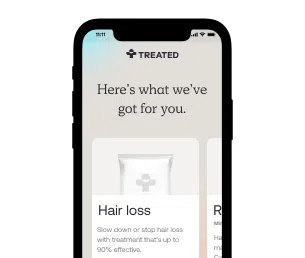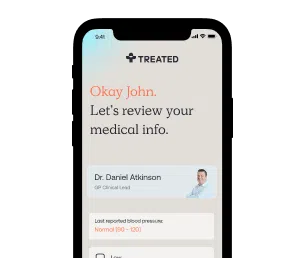Ear wax treatment
Remove excess wax at home.
Secure delivery
UK clinicians
We all have earwax, but when you have too much, it can affect your hearing and cause uncomfortable symptoms.
Talk to us about your health, and we’ll recommend the right treatments just for you. Order ear wax treatment online, and get your medication delivered to your door.
Ear wax is a substance made of dead skin cells, oils produced by the skin, debris, and a substance called cerumen. It’s a substance that we all produce in the outer ear canal, and it’s actually quite useful. It provides lubrication and protects our ears from external threats like bacteria, fungi, and water.
But sometimes you may produce more ear wax than you need, which can cause some irritating symptoms. This overproduction of wax leads to what’s commonly referred to as ear wax buildup.
Anyone can get ear wax buildup, as we all have it. But some people naturally produce more wax than others or have more narrow ear canals that get impacted more easily. Ear wax buildup is also much more common in children under five and people over fifty.
People who try to clean their ear canal by themselves using foreign bodies are at a much higher risk of becoming impacted as well. So you might want to avoid using cotton swabs to clean out your ears.
Ear wax build-up is a very common condition. Statistics show that 2.3 million in the UK need treatment for ear wax impaction each year. This is much more common in older populations, and it’s estimated that 18 to 65% of people over 65 years old suffer from ear wax build-up.

How we source info.
When we present you with stats, data, opinion or a consensus, we’ll tell you where this came from. And we’ll only present data as clinically reliable if it’s come from a reputable source, such as a state or government-funded health body, a peer-reviewed medical journal, or a recognised analytics or data body. Read more in our editorial policy.
Some people are simply more prone to ear wax buildup, as they make more than the average person. But there are some other risk factors that can lead to impaction. These include:
Cleaning the ear with a cotton bud can push the wax back into the canal and cause buildup. As a general rule, to prevent ear wax buildup you should avoid inserting any foreign objects in your ears.
When you’re examined by a clinician, they might ask a few questions to check if you have ear wax buildup symptoms, and then they’ll look inside your ears using an otoscope to confirm their diagnosis. But you can also be diagnosed and treated without having your ears examined. The clinician might ask you about some other signs of ear wax buildup, like:
The symptoms associated with ear wax buildup can end up affecting your quality of life, and ear wax impaction can increase your chance of infections. Using cotton buds to clean your ears can both cause impaction and lead to infections, so try not to use them.
If you have any signs of infection, you should see a clinician straight away so they can treat you. Ear wax buildup can make it hard for clinicians to examine your ears, so they might have to rely on your symptoms to confirm an infection.

How we source info.
When we present you with stats, data, opinion or a consensus, we’ll tell you where this came from. And we’ll only present data as clinically reliable if it’s come from a reputable source, such as a state or government-funded health body, a peer-reviewed medical journal, or a recognised analytics or data body. Read more in our editorial policy.
Ear wax buildup can be treated at home with some natural remedies. For example, you can put a couple of drops of medical-grade olive or almond oil in your ear a few times a day. A mix of water and sodium bicarbonate can loosen ear wax build-up too.
Other than home remedies, you can get drops from a pharmacy, which are ear drops often used for impacted ear wax or excess wax. Hydrogen peroxide drops are often the go-to if olive oil or sodium bicarbonate drops haven’t helped. You can also have a non-invasive procedure like ear irrigation and ear wax suction. Keep in mind that not all clinicians offer this service.
The best ear wax buildup treatment usually depends on the person and what works for you. A clinician can work with you to find it. If you tell us about your symptoms, we’ll help you find the best treatment for you.
The first treatment recommended for ear wax buildup is usually ear drops. There are a few different drops you can try. But if these don’t work, and they might not, you should go back to the clinician for further advice. They might then recommend non-surgical procedures like vacuuming, to remove impacted ear wax.
Ear wax usually falls out on its own, but once the wax becomes impacted you’ll usually need treatment. If the symptoms are affecting your daily life or causing discomfort, you may also want to talk to a clinician.
You can try simple ways to get rid of ear wax build-up, such as using natural olive or almond oil as ear drops a few times a day or sodium bicarbonate drops which you can prepare at home or get from a registered pharmacy.

How we source info.
When we present you with stats, data, opinion or a consensus, we’ll tell you where this came from. And we’ll only present data as clinically reliable if it’s come from a reputable source, such as a state or government-funded health body, a peer-reviewed medical journal, or a recognised analytics or data body. Read more in our editorial policy.
Have something specific you want to know? Search our info below, or ask our experts a question if you can’t find what you’re looking for.
Earwax impaction: Symptoms, predisposing factors and perception among Nigerians. Journal of Family Medicine and Primary Care, 3(4), p.379. [Accessed 6 Sep. 2019].
CKS is only available in the UK. [Accessed 21 Nov. 2021].
[Accessed 21 Nov. 2021].
Management of earwax. www.ncbi.nlm.nih.gov. National Institute for Health and Care Excellence (UK). [Accessed 21 Nov. 2021].

Remove earwax, get rid of pain. Easy to use drops with no prescription needed.

Easy to use olive oil drops. Effective earwax treatment, with no prescription needed.

Easy to use, quick to deliver. Otex drops clear out your ears so you can live normally again.

Registered with GMC (No. 4624794)
Meet Daniel
Registered with GPhC (No. 2202465)
Meet Sanjeda
Registered with GPhC (No. 2070724)
Meet Craig
Always read the leaflet that comes with your medication and tell us about any side effects you get.
We know health, but you know you.
Our experts tell you what’s safe, but you decide what’s best.
Answer a few questions and tell us about yourself. Get tailored advice from our clinicians so you can choose better.

Choose your treatment and how often you have it delivered.

We know things change. It’s the nature of life. We’ll check in regularly to make sure your treatment is still right for you.
Pause. Change. Skip. Start again. Any time you like.
Here are some other things we can help with.
Choose from our range of tablets and solutions. Get ongoing care and support from our experts.
Stop smoking treatments that can help you kick the habit forever, and reduce your risk of disease.
Tablets or injections. Tailored weight loss treatments combined with ongoing support from our experts.
We're making healthcare more about you. Sign up to our newsletter for personalised health articles that make a difference.
Disclaimer: The information provided on this page is not a substitute for professional medical advice, diagnosis, or treatment. If you have any questions or concerns about your health, please talk to a doctor.
We couldn't find what you're looking for.
Here's everything we treat. Or, if you're looking for something we don't have yet, you can suggest something.
If there’s a particular treatment or condition you’re looking for, tell us and we’ll look into it for you.
Submit your question here, or tell us if you’ve found an issue on our site.
We’ll get back to you very soon. We aim to respond to all queries in one working day.
You’re signed up to our newsletter. Keep an eye on your inbox for our latest update.
By clicking 'Subscribe now' you're agreeing to our Privacy Policy.
We’ve sent you an email asking you to confirm your email address.